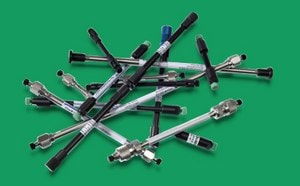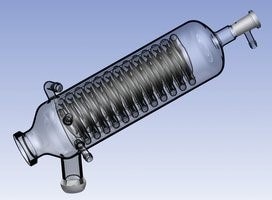Small Molecule HPLC

Analysis of Small Molecules
A small molecule refers to a compound of low molecular weight (typically less than 900 daltons). Some common examples of small molecules include amino acids, lipids, sugars, fatty acids, alkaloids, and others.
Different methods are available for the separation of small molecules including High Performance liquid chromatography (HPLC), liquid chromatography (LC), gas chromatography (GC), thin-layer chromatography (TLC) and capillary electrophoresis (CE). Furthermore, the options for their identification include nuclear magnetic resonance spectroscopy (NMR) or mass spectrometry (MS). Liquid chromatography coupled with mass spectrometry (LC-MS) became a key technique for the identification of small molecules during recent years.
Getting the best possible results in the high-performance liquid chromatography (HPLC), UHPLC or LC-MS analysis of small molecules depends on the selection of the best suitable stationary phase and mobile phase conditions. The chemistry of the analyte is key for selecting the best suitable column chemistry. Other aspects such as speed, sample matrix, and number of compounds define the best suitable base material for the stationary phase.
Featured Categories
Elevate filtration: glass, stainless steel, plastic filter holders for liquid, gas. Syringe, in-line, vacuum, pressure choices await.
Achieve precise separations with our extensive HPLC column collection. Enhance retention, resolution, and selectivity. Order today.
Optimize sampling: Hamilton, SGE, VICI® Precision Sampling syringes - standard, high-quality. Select based on application, compatibility, preference.
Aldrich® chemistry glassware offers a full range of standard beakers, flasks, tubing, reaction vessels, chromatography columns and custom glassblowing services.
HPLC of Small Molecules
The HPLC analysis of small molecules most often is performed in reversed-phase separation mode. For separation of polar compounds hydrophilic interaction chromatography (HILIC) and normal-phase chromatography are suitable as well, with HILIC being the preferred method. For the separation of ionic compounds, ion-exchange separation modes and for inorganic anions or cations, ion chromatography can also be used.
The HPLC column is packed with either fully porous silica particles, superficially porous silica particles, polymeric particles or consists of a monolithic silica rod as the stationary phase. In addition, alumina oxide, zirconia particles and Carbon particles are used. The typical pore size of the stationary phase material for small molecule separation is in the range of 60 Å - 160 Å. For HPLC the typical particle size of the stationary phase ranges from 3 µm to 5 µm, for UHPLC smaller particles sizes, typically 2 µm or below, are used. Different column selectivities (modifications) can be attached to the stationary phase. A C18 alkyl chain is the most commonly used column chemistry in reversed phase (RP) chromatography. Nevertheless, other modifications, such as C30, C8, Phenyl, Pentaflourophenyl and a broad range of more polar modifications as well as modifications with ion-exchange or chiral properties enable the separation of almost all compounds soluble in liquids. The mobile phase for RP-HPLC typically consists of an aqueous buffer or water and water-miscible organic solvents like acetonitrile or methanol.
HPLC Sample Preparation
Complex and matrix-rich samples, such as food, beverages, cosmetics, biological samples and matrix-rich pharmaceutical formulations (e.g. cream, syrup) require efficient sample preparation protocols to remove unwanted components and selectively extract the analyte of interest. This is critical if a stationary phase with very small particle sizes as in UHPLC, where particles of 2 µm or below are used. Common sample preparation methods are Liquid-liquid extraction, Solid phase extraction (SPE) and for biological samples also protein precipitation beside filtration. In addition to the selective elution of the target compound and pre-concentration, the main purpose of sample preparation is to protect the HPLC stationary phase from clogging caused by the sample matrix. HPLC columns based on monolithic silica can tolerate matrix to a high extend and require much less sample preparation than particulate columns.
Derivatization
For some molecules derivatization is required, either before (pre-column) or after (post-column) the HPLC separation. The derivatization converts molecules into their derivatives for better sensitivity or chromatographic retention in HPLC. Chemical reagents, with desirable physical and chemical properties, are used for the required derivatization.
Visit our document search for data sheets, certificates and technical documentation.
Related Articles
- Chromolith® HPLC and UHPLC columns are made from monolithic silica with a bimodal pore structure using sol-gel technology.
- Review the effects of efficiency (plate number), retention, and selectivity factors on HPLC resolution. See how factors relate to particle and column characteristics via the HPLC resolution equation.
- Supel™ Carbon LC U/HPLC columns facilitate high-temperature and high-pressure separation of polar or charged compounds.
- LC-MS sensitivity optimization tips minimize contaminations, enhancing detection limits and spectrum clarity for accurate analysis.
- This study demonstrates the impact of various mobile phase modifiers on the separation; formate modifiers outperform acetate in terms of MS signals (or sensitivity) and chromatographic resolution.
- See All (169)
Related Protocols
- Chromolith® HPLC and UHPLC columns are made from monolithic silica with a bimodal pore structure using sol-gel technology.
- Review the effects of efficiency (plate number), retention, and selectivity factors on HPLC resolution. See how factors relate to particle and column characteristics via the HPLC resolution equation.
- Supel™ Carbon LC U/HPLC columns facilitate high-temperature and high-pressure separation of polar or charged compounds.
- LC-MS sensitivity optimization tips minimize contaminations, enhancing detection limits and spectrum clarity for accurate analysis.
- This study demonstrates the impact of various mobile phase modifiers on the separation; formate modifiers outperform acetate in terms of MS signals (or sensitivity) and chromatographic resolution.
- See All (84)
Find More Articles and Protocols
How Can We Help
In case of any questions, please submit a customer support request
or talk to our customer service team:
Email custserv@sial.com
or call +1 (800) 244-1173
Additional Support
- Chromatogram Search
Use the Chromatogram Search to identify unknown compounds in your sample.
- Calculators & Apps
Web Toolbox - science research tools and resources for analytical chemistry, life science, chemical synthesis and materials science.
- Customer Support Request
Customer support including help with orders, products, accounts, and website technical issues.
- FAQ
Explore our Frequently Asked Questions for answers to commonly asked questions about our products and services.
To continue reading please sign in or create an account.
Don't Have An Account?



